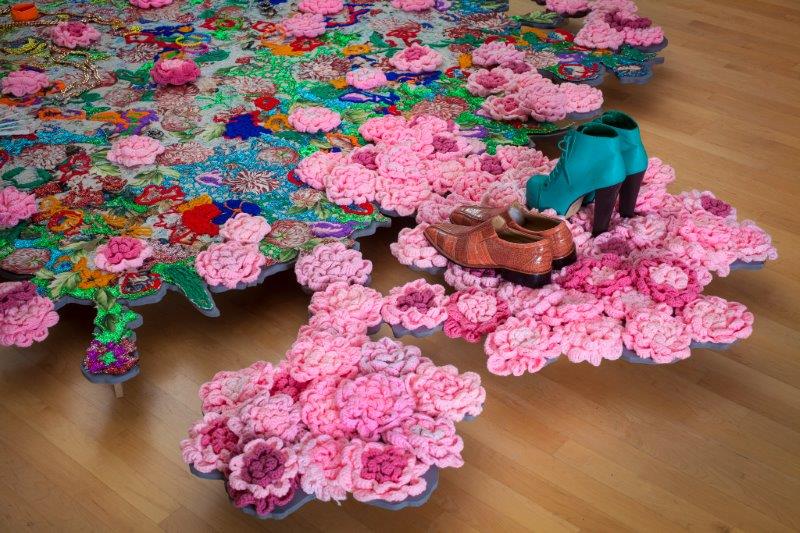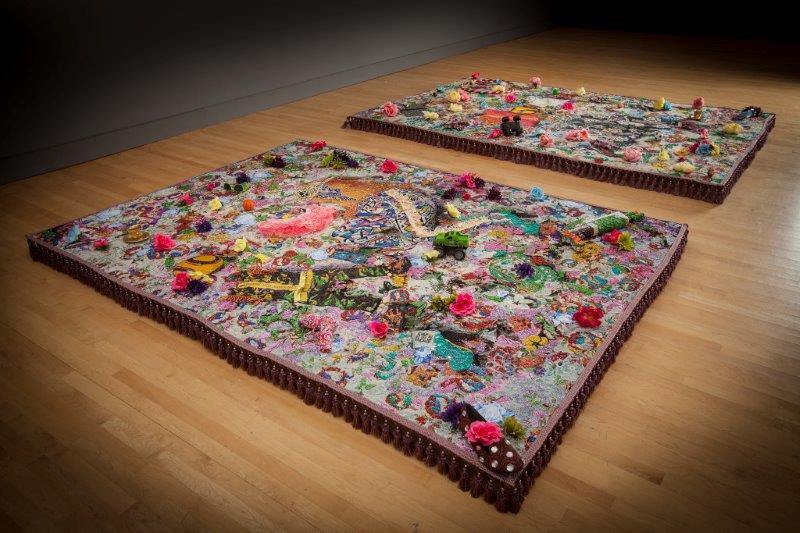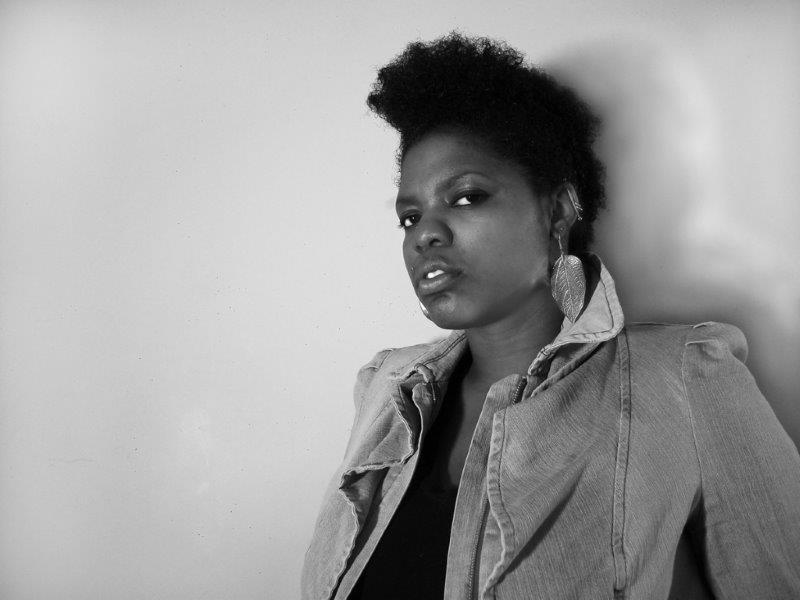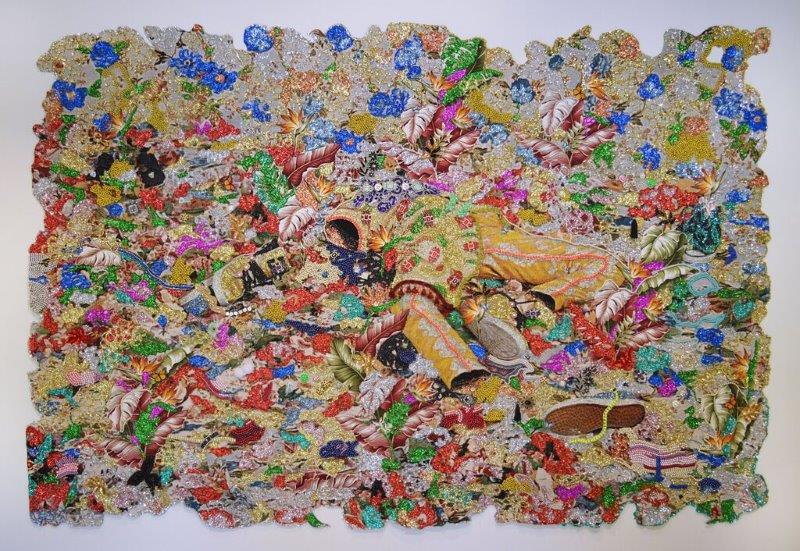Art & Exhibitions
The Disturbing Truth Buried Within Ebony G. Patterson’s Lavish Tapestries
What lies beneath is deep. Very deep.

What lies beneath is deep. Very deep.

Clara Zevi


Ebony G. Patterson, In Rest-Dead Treez (2015).
Photo: Monique Meloche Gallery, courtesy the artist.
Colorful clumps of flowers, crochet leaves and layers of woven gems are what first catch the eye in artist Ebony G. Patterson’s new tapestries, which make their debut next month at Monique Meloche Gallery in Chicago. But take a closer look at the group of impressively large floor pieces, each measuring around eight feet wide and over six feet long, and you’ll find disturbing forces within the works.
Patterson’s first step in creating these multi-layered works is to scour the Internet for images of murder victims, using popular image-sharing sites as a starting point. “Over the past two or three years I’ve been collecting images via social media…of people [who] have died violently,” she says, explaining the morbid backdrops.
It is the circulation of these images and the visibility of their subjects, people of color that may otherwise go unseen, that interests Patterson most.
The artist takes the figure from these photographs and applies the shape of the body onto the base of the tapestry. Then she adds elaborate beading, heavy sequins and crochet to create a layered visual experience.
“The audience is seduced by all of the prettiness,” Patterson said of her new work. But once we dig through the foliage and bright hues that the Jamaican-born artist initially applies, we unearth “the underreported and unacknowledged brutality experienced by those on the lower rungs of the socio-economic ladder,” according to the press release.

Installation view of ‘Root and Shrub’ at the Kohler Arts Center (2014).
Photo: Monique Meloche Gallery, courtesy the artist.
“I’m interested in the idea of implicating the viewer as witness, as if they are stumbling upon these crime scene moments,” the artist said in a phone interview with artnet News.
“I’m hoping by slowing the viewer down in these experiences, through the use of objects and this really encrusted surface, to pull the viewer in to see further and raise questions about how we engage in the act of looking.”

Close-up of one of Patterson’s floor tapestries currently on view at the John Michael Kohler Arts Center.
Photo: Monique Meloche Gallery, courtesy the artist.
Photographs and video footage of Baltimore resident Freddie Gray being arrested circulated the web at incredible speed. The haunting photographs of Ferguson, Missouri, resident Michael Brown’s dead body, that for hours remained in plain view, spread quickly online. We are becoming too used to seeing such scenes of young black men and women as victims of police repression. Dotted throughout our news feeds, these photographs occupy the same space as filtered sunsets and other snippets of everyday life.
“We don’t even identify the person in the images as people anymore, they are purely objects. There is a total disconnect between what has actually happened in the picture and how we relate to it,” Patterson, who holds an MFA in printmaking and drawing from Washington University in St. Louis, told artnet News.

Ebony G. Patterson.
Photo: courtesy Monique Meloche Gallery and the artist.
The embellishment and lush details splayed on top of the somber images are not new to the artist’s work. Long fascinated by the aesthetic and symbolic aspects of Jamaican dancehall culture, Patterson uses over the top decoration to explore how we perceive certain colors and motifs and how we adapt our notion of beauty depending on whether the subject is viewed as male or female.
This is particularly true in her upcoming show at the Museum of Arts and Design in New York, titled “Ebony G. Patterson: Dead Treez,” which focuses on masculinity in Jamaica through six colorful tapestries and 10 fashion-forward male mannequins, covered in floral patterns.
As it became mainstream in the early 2000s to apply a more fluid attitude towards gender and sexuality, a whole new vocabulary came available to young men. “Words that would not be associated with the masculine—like pretty and dainty—these are words that have come in through the ushering of the trend of metrosexuality,” Patterson told artnet News.
Kehinde Wiley‘s paintings encourage a similar conversation about challenging notions of gender and sexuality, in particular masculinity, within contemporary portraiture. Known for painting young black men (and, more recently, women) in traditional, Old European master painting poses, Wiley has upended our expectations of what traditional portraiture is supposed to do. In some works young men lie seductively, locking eyes with the viewer—and queering the gaze in the process.

Ebony G. Patterson, Golden Rest-Dead Treez (2015).
Photo: Monique Meloche Gallery, courtesy the artist.
It is not just Patterson’s subject matter that make her upcoming solo show one not to miss, but the artist’s foray into embroidery also binds her work into the broader context of female and black queer aesthetics.
Embroidery has always carried a highly gendered connotation, and countless modern and contemporary female artists have used the practice in their art. Louise Bourgeois not only wove some of her works together, but the spider, an important icon in her extensive oeuvre, holds explicit connections to her mother, who was a tapestry restorer.
Sheila Hicks is another prominent voice in the discussion. The artist thinks of her thick, hanging textiles as three dimensional drawings. In a 2012 interview, Hicks told artnet News, “Textile has been relegated to a secondary role in our society, to a material that was considered either functional or decorative. I wanted to give it another status and show what an artist can do with these incredible materials.”
Patterson was a favorite at last year’s UNTITLED at Art Basel Miami Beach and this will be her third solo show at Monique Meloche Gallery, and her first show at the Museum of Arts and Design. She splits her time between Kingston, Jamaica and Lexington, Kentucky.
“unearthed treez” will be on view at Monique Meloche Gallery, September 12–October 24, 2015; “Ebony G. Patterson: Dead Treez” will be on view at the Museum of Arts and Design, November 10, 2015–April 3, 2016.
Related Stories:
artnet News’s Top 10 Most Expensive Living Women Artists 2015